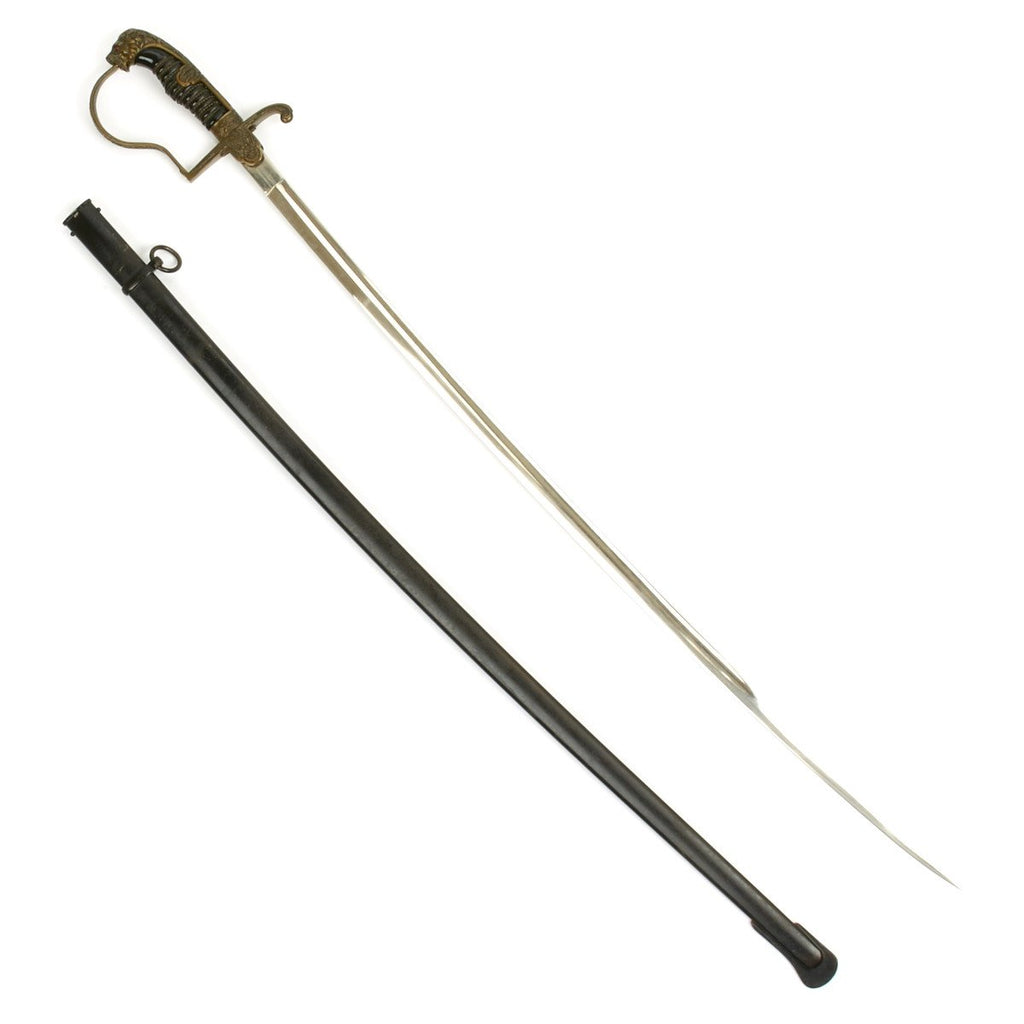Item Description
Original Item: This is a beautiful classic Lionhead German WWII Officer sword. The all brass hilt consists of a finely detailed lion head cat with oak leaf backstrap and "P" guard. The cat is fitted with blood red faceted eyes. Nice detail throughout his whiskers, chin, and muzzle. The handwork is beautifully rendered throughout this brass. The backstrap consists of raised out oak leaves with double leaves flowing into the side tabs.
This lionhead sword hilt features an outstanding feline head with faceted eyes. The features of this lion's head have been nicely hand rendered to the bottom of the jaw, the whiskers, the eyelids and the mane which runs backward slightly down the sword. Prior to the center area, there is some nice clamshell type renderings which have hand accenting as well as hand pebbled surfaces. The "D" guard has raised out oak leafing as does the ferrule.
The crossguard has a typical Alcoso style open winged eagle which looks to the viewer's right. The breast area of this eagle, as well as the legs and the wreath enclosing the swas, have all been hand enhanced. Nice looking hilt here reflecting approximately some gilded finish.
The scabbard of this example still has good original factory paint. This paint remains bright in places with some wear in others. There are no dings or dents.
The grip is an outstanding black celluloid-over-wood base. It is wrapped with triple-twisted brass wire, the center being larger. The blade of this example is really something. This blade is a highest quality nickel-plated example still remaining bright and in mint condition. The blade measures 32 inches in length. Factory catalogs specify blades were available up to 35 inches. The reverse ricasso is stamped with the trademark used from 1937-1939. It depicts the scales with the firm's initials, "ACS" interspersed. Above is the firm's name, "Alcoso" arch shaped and below the town of business, "Solingen".
ALCOSO is a trade name of Alexander Coppel & Co. KG, Stahlwarenfabrik, located in Solingen, the legendary German "City of Blades." The company was a major manufacturer of edged weapons and tools from the end of the 19th century up until the WWII period. Unfortunately, as NSDAP-control increased, brothers Carl Gustav and Dr. Alexander Coppel, the Jewish owners of the firm, were forced out. In 1936 the firm had been "Aryanized", and started using the name ALCOSO to hide the Jewish family name. By the end of 1936 the brothers were ejected from their Solingen offices, and by 1940 the brand trademark initials ACS were changed to AWS to reflect the change in ownership and name: Alexander Coppel Solingen to Alcoso-Werk Solingen. Carl Gustav Coppel committed suicide in Solingen in 1941, and Dr. Alexander Coppel was arrested in 1942 and sent to Theresienstadt Prison camp, where he died August 5th 1942.
A rare sword here and a nice addition to any sword collection.
The German Army (German: Heer, was the land forces component of the Wehrmacht, the German armed forces, from 1935 to 1945. The Wehrmacht also included the Kriegsmarine (Navy) and the Luftwaffe (Air Force). During World War II, a total of about 15 million soldiers served in the German Army, of whom about seven million became casualties. Separate from the army, the Waffen-SS (Armed SS) was a multi-ethnic and multi-national military force of the Third Reich. Growing from three regiments to over 38 divisions during World War II, it served alongside the army but was never formally part of it.
Only 17 months after AH announced publicly the rearmament program, the Army reached its projected goal of 36 divisions. During the autumn of 1937, two more corps were formed. In 1938, four additional corps were formed with the inclusion of the five divisions of the Austrian Army after the Anschluss in March. During the period of its expansion by Adolf AH, the German Army continued to develop concepts pioneered during World War I, combining ground (Heer) and air (Luftwaffe) assets into combined arms teams. Coupled with operational and tactical methods such as encirclements and the "battle of annihilation", the German military managed quick victories in the two initial years of World War II, prompting the use of the word Blitzkrieg (literally lightning war, meaning lightning-fast war) for the techniques used.
The German Army entered the war with a majority of its infantry formations relying on the horse for transportation. The infantry remained foot soldiers throughout the war; artillery also remained primarily horse-drawn. The motorized formations received much attention in the world press in the opening years of the war, and were cited as the main reason for the success of the German invasions of Poland (September 1939), Norway and Denmark (April 1940), Belgium, France and Netherlands (May 1940), Yugoslavia (April 1941) and the early campaigns in the Soviet Union (June 1941). However their motorized and tank formations accounted for only 20% of the Heer's capacity at their peak strength.
- This product is available for international shipping. Shipping not available to: Australia, France, or Germany
- Due to legal restrictions this item cannot be shipped to Australia, France or Germany. This is not a comprehensive list and other countries may be added in the future.
- Not eligible for payment with Paypal or Amazon

























